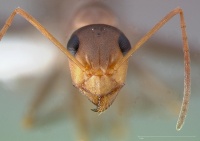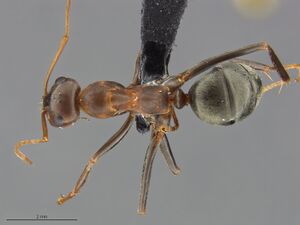Formica xerophila
| Formica xerophila | |
|---|---|

| |
| Scientific classification | |
| Kingdom: | Animalia |
| Phylum: | Arthropoda |
| Class: | Insecta |
| Order: | Hymenoptera |
| Family: | Formicidae |
| Subfamily: | Formicinae |
| Tribe: | Formicini |
| Genus: | Formica |
| Species: | F. xerophila |
| Binomial name | |
| Formica xerophila Smith, M.R., 1939 | |
| Synonyms | |
| |
Nests are found in the soil.
Identification
This species can be easily recognized by the thick petiole with a blunt apex, as seen in profile. Additionally it is pale brown with a slightly darker gaster. The propodeum is low, about the same level as the lowest point (posterior edge) of the mesonotum. The region between the two faces is broadly rounded. The metasternal process is poorly developed; there are few erect hairs, which are restricted to the clypeus, dorsum of the head and dorsum of the gaster. (Mackay and Mackay 2002)
Keys including this Species
Distribution
United States: Washington, California, Nevada, Utah, Arizona and New Mexico.
Latitudinal Distribution Pattern
Latitudinal Range: 47.551° to 19.35692°.
| North Temperate |
North Subtropical |
Tropical | South Subtropical |
South Temperate |
- Source: AntMaps
Distribution based on Regional Taxon Lists
Nearctic Region: United States (type locality).
Neotropical Region: Mexico.
Distribution based on AntMaps
Distribution based on AntWeb specimens
Check data from AntWeb
Countries Occupied
| Number of countries occupied by this species based on AntWiki Regional Taxon Lists. In general, fewer countries occupied indicates a narrower range, while more countries indicates a more widespread species. |

|
Estimated Abundance
| Relative abundance based on number of AntMaps records per species (this species within the purple bar). Fewer records (to the left) indicates a less abundant/encountered species while more records (to the right) indicates more abundant/encountered species. |

|
Habitat
In New Mexico (Mackay and Mackay 2002) - This species occurs in habitats that include a variety of arid, semi-arid and pine forest types.
Biology
Nevada, Wheeler and Wheeler (1986) - This species has been found only in the southern and western parts of the state. We have 29 records from 20 localities; 4,200 ft.-6,500 ft. One record is from a Sarcobatus Subclimax in the Hot Desert, 3 from the Cool Desert (2 from disturbed habitats), while the majority (19) are from the Pinyon-Juniper Biome. Five nests were under stones, 1 under dead wood; of the exposed nests 5 were surmounted by messy piles of excavated soil and 7 by craters 7-22 cm in diameter with entrances 15-20 mm in diameter.
Castes
Worker
   
| |
| Worker. . | Owned by Museum of Comparative Zoology. |
Nomenclature
The following information is derived from Barry Bolton's Online Catalogue of the Ants of the World.
- xerophila. Formica (Neoformica) moki subsp. xerophila Smith, M.R. 1939f: 583 (w.) U.S.A. Raised to species and senior synonym of grundmanni: Francoeur, 1973: 259.
- grundmanni. Formica moki subsp. grundmanni Cole, 1943b: 184 (w.) U.S.A. Junior synonym of xerophila: Francoeur, 1973: 259.
Unless otherwise noted the text for the remainder of this section is reported from the publication that includes the original description.
Description
References
- Alatorre-Bracamontes, C.E., Vásquez-Bolaños, M. 2010. Lista comentada de las hormigas (Hymenoptera: Formicidae) del norte de México. Dugesiana 17(1): 9-36.
- Borowiec, M.L., Cover, S.P., Rabeling, C. 2021. The evolution of social parasitism in Formica ants revealed by a global phylogeny. Proceedings of the National Academy of Sciences 118, e2026029118 (doi:10.1073/pnas.2026029118).
- Cole, A. C., Jr. 1943b. A new subspecies of Formica moki Wheeler (Hymenoptera: Formicidae). Am. Midl. Nat. 29: 183-184.
- Francoeur, A. 1973. Révision taxonomique des espèces néarctiques du groupe fusca, genre Formica (Formicidae, Hymenoptera). Mém. Soc. Entomol. Qué. 3: 1-316 (page 259, Raised to species, and senior synonym of grundmanni)
- Mackay, W. P. and E. Mackay. 2002. The ants of New Mexico (Hymenoptera: Formicidae). Edwin Mellen Press, Lewiston, NY.
- Smith, M. R. 1939f. Notes on Formica (Neoformica) moki Wheeler, with description of a new subspecies (Hymenoptera: Formicidae). Ann. Entomol. Soc. Am. 32: 581-584.(page 583, worker described)
- Wheeler, G. C. and J. Wheeler. 1986. The ants of Nevada. Natural History Museum of Los Angeles County, Los Angeles.
References based on Global Ant Biodiversity Informatics
- Allred D. M. 1982. Ants of Utah. The Great Basin Naturalist 42: 415-511.
- Allred, D.M. 1982. The ants of Utah. Great Basin Naturalist 42:415-511.
- Boulton A. M., Davies K. F. and Ward P. S. 2005. Species richness, abundance, and composition of ground-dwelling ants in northern California grasslands: role of plants, soil, and grazing. Environmental Entomology 34: 96-104
- Cole A. C., Jr. 1943. A new subspecies of Formica moki Wheeler (Hymenoptera: Formicidae). American Midland Naturalist 29: 183-184.
- Des Lauriers J., and D. Ikeda. 2017. The ants (Hymenoptera: Formicidae) of the San Gabriel Mountains of Southern California, USA with an annotated list. In: Reynolds R. E. (Ed.) Desert Studies Symposium. California State University Desert Studies Consortium, 342 pp. Pages 264-277.
- Francoeur. A. 1973. Revision taxonomique des especes nearctiques du group fusca, genre Formica. Memoires de la Societe Entomologique du Quebec 3: 1-316.
- Johnson R. Personnal Database. Accessed on February 5th 2014 at http://www.asu.edu/clas/sirgtools/resources.htm
- Johnson, R.A. and P.S. Ward. 2002. Biogeography and endemism of ants (Hymenoptera: Formicidae) in Baja California, Mexico: a first overview. Journal of Biogeography 29:10091026/
- Longino, J.T. 2010. Personal Communication. Longino Collection Database
- Mackay W. P., and E. E. Mackay. 2002. The ants of New Mexico (Hymenoptera: Formicidae). Lewiston, New York: Edwin Mellen Press, 400 pp.
- Vásquez-Bolaños M. 2011. Lista de especies de hormigas (Hymenoptera: Formicidae) para México. Dugesiana 18: 95-133
- Wheeler G. C., and J. Wheeler. 1986. The ants of Nevada. Los Angeles: Natural History Museum of Los Angeles County, vii + 138 pp.


